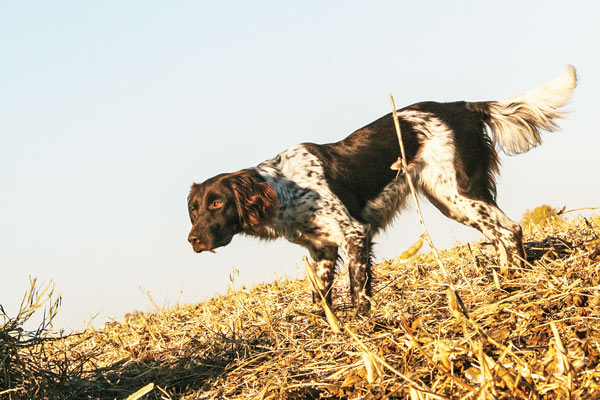 "A small what?" was the typical response Jim Julson used to get when he answered the common question: "What kind of a dog do you have there?"
"A small what?" was the typical response Jim Julson used to get when he answered the common question: "What kind of a dog do you have there?"
"This is a Small Munsterlander," Julson would repeat. He then would go on to explain, as he had done dozens of times in the 20 years he has owned the breed, what a Small Munsterlander is.
"The Small Munsterlander originally came from the Munsterland region in the northwestern part of Germany, where the breed was developed to hunt upland gamebirds and waterfowl as well as track and find small and big wounded game animals," Julson says. "As we know the breed today, the Small Munsterlander was developed in the early 1900s by reviving some original old lines of a locally produced small, long-haired pointing dog and adding to the basic Small Munsterlander brood stock other breeds including the Large Munsterlander and the French Brittany."
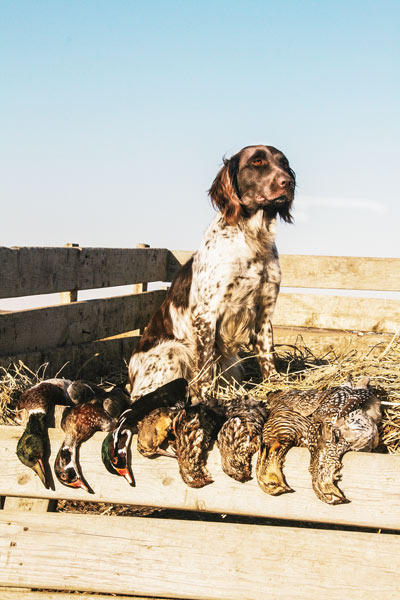 In the early 20th century, Small Munsterlander breed clubs were formed and breed standards were established in Germany and other continental countries. By the 1970s a few Small Munsterlanders started to appear in the U.S. and Canada. The Small Munsterlander Club of North America was formed at that time and the popularity of the Small Munsterlander slowly developed with a growing interest in the breed coming about more recently.
In the early 20th century, Small Munsterlander breed clubs were formed and breed standards were established in Germany and other continental countries. By the 1970s a few Small Munsterlanders started to appear in the U.S. and Canada. The Small Munsterlander Club of North America was formed at that time and the popularity of the Small Munsterlander slowly developed with a growing interest in the breed coming about more recently.
When asked why he settled on this breed, Julson replies, "Because, in my opinion, there is nothing prettier or more impressive than a Small Munsterlander on point with its head and tail held high in a perfect pose. The silky hair on the legs and ears and the long hair on the long tail make for a classic picture of the ideal gun dog.
"Another reason to want a Small Munsterlander is to watch one go through thick, tall cattails to find a wounded Canada honker that swims 200 yards into ice cold, wind-whipped water. Fifteen minutes later the 38-pound Small Munsterlander comes paddling back to deliver a 10-pound goose. That's another good reason to own a versatile Small Munsterlander."
Julson is not alone in his appreciation of the Small Munsterlander's small size, striking appearance, and strong versatility as a hunter. "On a trip to Germany back in the early 1970s, I saw a Small Munsterlander and was impressed with the way this relatively small German dog naturally quartered in the field and naturally pointed upland game birds," says Tom McDonald, one of the first hunters to bring the Small Munsterlander to North America.
"I also was impressed by the way the dog retrieved on land and out of water. And I was really pleased with the calm temperament of the Small Munsterlander around other dogs and other domestic animals as well as having good manners as a house dog," McDonald recollects.
American Roots
McDonald's early experience with the Small Munsterlander encouraged him to partner with his hunting buddy, Paul Jensen, to form the Small Munsterlander Club of North America. The organization developed a relationship with NAVHDA for certified hunt tests. The SMCNA also maintained a close connection with the official European Small Munsterlander groups to keep close genetic ties with dogs from the continent.
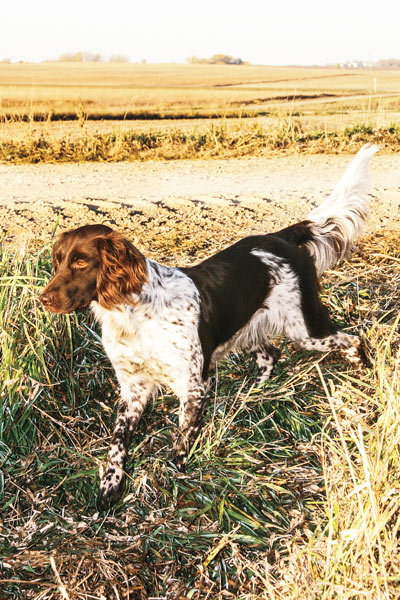 A second Small Munsterlander club has recently emerged in the United States. The Kleine (German for "small") Munsterlander-Group North America, or KLMGNA, was formed to develop a closer relationship with the German Small Munsterlander club in order to increase the standards for training and hunt testing. To accomplish this objective the group is working to bring in more award-winning Small Munsterlander genetics from European countries. The KLMGNA has also added blood tracking to the requirements for passing grades in the club's hunt test program. See klm-gna.org for more information.
A second Small Munsterlander club has recently emerged in the United States. The Kleine (German for "small") Munsterlander-Group North America, or KLMGNA, was formed to develop a closer relationship with the German Small Munsterlander club in order to increase the standards for training and hunt testing. To accomplish this objective the group is working to bring in more award-winning Small Munsterlander genetics from European countries. The KLMGNA has also added blood tracking to the requirements for passing grades in the club's hunt test program. See klm-gna.org for more information.
"Generally, I've found that Small Munsterlanders are as easy to train as most any other breed of versatile gun dog," says Ed Erickson, a professional dog trainer from Isle, Minnesota. "A few might be late bloomers and some may be a little stubborn, but most are as quick to learn and are as level-headed as German shorthairs.
"In most cases, Small Munsterlanders born in late winter or early spring can (with training) hunt the first fall, but don't expect a fully-matured performance," Erickson adds.
"Do expect your young Small Munsterlander to get some good hunting exposure and contribute to the hunting experience."
Though most Small Munsterlanders are "natural retrievers," many owners use a "trained retrieve" to ensure a particular dog will dependably fetch when in a field or water "testing" experience or on a hunting trip. "I use a trained retrieve or force-fetching method on all my Small Munsterlanders mainly to insure a dependable search, pick up, and return of any bird I send them after during any kind of NAVHDA or German-type tests," says John Liscovitz, president of KLMGMA.
"I do my force-fetching in five-minute sessions to avoid creating anxiety and resentment in the dogs. Going at it any longer just creates problems whereas shorter lessons over a longer time seem to keep the dogs more receptive and happier."
House vs. Kennel
While at work, many Small Munsterlander owners keep their dogs in outside kennel runs during the day then bring them into their homes at night (and all day on weekends and holidays). The breed is consistently described as a very good house dog.
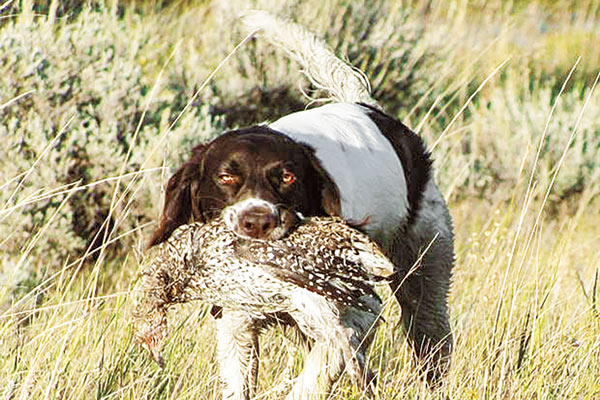 "The relatively small size and mild temperament of most Small Munsterlanders make them easy keepers outside where a medium-size kennel run will be enough to adequately hold them," says Allison Wilmer of Phoenix, Arizona. "And inside the house my Small Munsterlanders can be set free and they stay calm without roaming all over or tearing up the place.
"The relatively small size and mild temperament of most Small Munsterlanders make them easy keepers outside where a medium-size kennel run will be enough to adequately hold them," says Allison Wilmer of Phoenix, Arizona. "And inside the house my Small Munsterlanders can be set free and they stay calm without roaming all over or tearing up the place.
"Our family and friends who hunt desert quail with us always comment on how calm and laid back Dot and Dolly, our two Small Munsterlanders, are in the house and out in the yard. But what a difference there is in their energy levels and working speed when we're on a hunt," Wilmer adds. "In talking to other Small Munsterlander owners, we've found that the majority chose the breed because they are good house dogs as well as natural hunters and easy to train."
For anyone in search of a Small Munsterlander pup, the usual guidelines apply. Do your homework—read about the breed and try to observe adult hunting dogs in the field and in water at hunt tests. Also, contact breeders and watch how Small Munsterlanders act in the house and in the yard at the breeders' homes.
See if you can be invited on a hunt to get a firm idea of how Small Munsterlanders perform on upland game birds (and small game animals) and waterfowl. Join one or both of the Small Munsterlander clubs to find pups from officially hunt tested parents and grandparents. Join a training and hunt testing organization. Carefully calculate the significance of the scores over several generations.
Inquire about certified general health exams for genetic flaws such as hip dysplasia when looking at the parents of a litter. Inquire about why this litter was produced and what the breeder's objectives were. Ask the breeder to discuss the individual differences they see in each pup.
What does the breeder do to evaluate each pup in terms of temperament, physical structure and conformation to predict physical performance and stamina in the field, and what do they do to expose the pups to such "outside" factors as other people, kids, terrain, birds, fur, weather and water?
Gaining Respect
"Hey, is that a Small Munsterlander?" the hunter said when he first saw one of the dogs belonging to Melissa Herz, a guide at a major commercial hunting enterprise in the state of Washington. Herz smiled when the client with the shotgun recognized her dogs as a breed becoming more recognizable in her part of the country—and maybe all across North America.
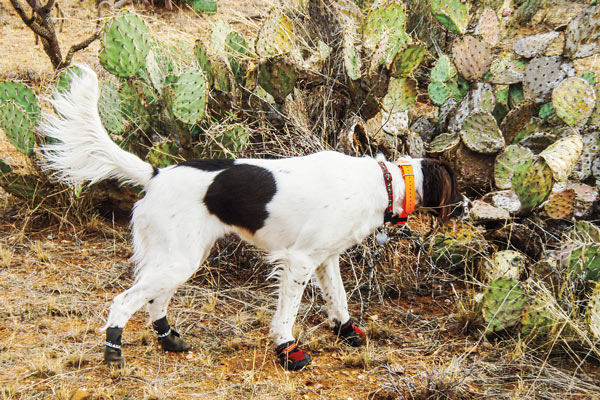 Herz has contributed to the Small Munsterlander's popularity by testing several of her dogs in NAVHDA, gaining Versatile Champion titles for two of them. She has used her prize-winning Small Munsterlanders to produce some special litters with pups sent to many states and parts of Canada. A Small Munsterlander belonging to Herz appeared on the cover of GUN DOG five years ago.
Herz has contributed to the Small Munsterlander's popularity by testing several of her dogs in NAVHDA, gaining Versatile Champion titles for two of them. She has used her prize-winning Small Munsterlanders to produce some special litters with pups sent to many states and parts of Canada. A Small Munsterlander belonging to Herz appeared on the cover of GUN DOG five years ago.
"The cover picture has been both a kind of blessing and sort of a curse," Herz says. "On one hand, the image helped to raise the profile of the breed with hunters interested in their versatility. On the other hand, I'm getting more calls from some people who say they are avid hunters but, I suspect, are really just looking for a canine companion or house dog that is simply 'something different,'" Herz says.
Because of this, Herz, like many Small Munsterlander breeders, thoroughly questions anyone who inquires about buying any of her dogs and quizzes everyone about what, where, and how often they hunt.
"Like most all our club members, I'm glad to see our dogs become family members, but they must first of all go to hunting homes where they will be used and proved in the field and on the water as versatile gun dogs," Herz states.






